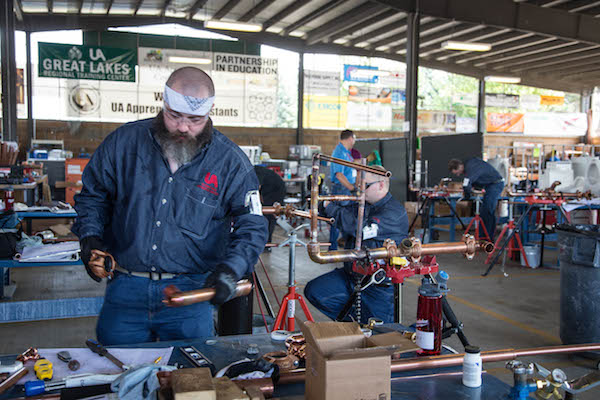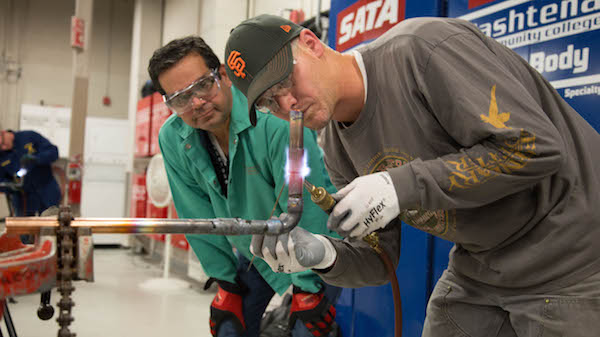The nation needs Millennials and Generation Z to consider trade careers
Your faucet’s leaking, it’s as simple as calling your local plumber to get the job done, right? Think again. Demand for plumbers all around the United States is on the rise, and soon there may not be enough tradespeople to answer your call.
More than 50% of America’s skilled trade employees are approaching retirement age, and fewer men and women across the nation are being prepared to take their places. To shed light on this issue, the Copper Development Association (CDA) released a new video that debunks myths discrediting the plumbing industry, and highlights how the trades are a viable, stable career path for millennials and Generation Z.
Young men and women need to know that going straight from high school into a four year college degree is not the only path they can take. For every building erected, piping will always need to be installed. It’s an intricate element to a healthy and growing economy and if the trades are not actively attracting young Americans, maintaining a strong, robust economy may prove difficult.
Understanding the Shortage
Only 3% of surveyed 18 to 25 year olds who have decided on a career path said they would pursue a career in a construction trade, according to the National Association of Home Builders. Yet, according to the Bureau of Labor Statistics, employment of plumbers, pipefitters, and steamfitters is projected to grow 16% from 2016 to 2026, much faster than the average for all occupations.

CDA partners with United Association (UA) local unions, PHCC chapters, vocational school programs, and contractors to participate in apprenticeship programs, conduct training courses and co-host competitions.
A survey done by RIDGID revealed that only 6% of high school students want to pursue a lifelong career working in trades. As young Americans lose interest, the U.S. has less plumbers, carpenters and electricians in the work field every year, while demand for these positions only climbs.
What Changed?
Times are changing. Craftsmen who grew up in the ‘70s and ‘80s had a different upbringing than their successors. After the 2008 financial crisis, academic higher learning became the favored route when compared to trade schools. As a result, and a persistent negative stigma of a skilled trades education and career, trade schools are becoming scarce around the country further expanding the employment gap.

As little as 20 years ago, craftsmanship was viewed in a completely different light. The trades, including plumbing companies used to be family owned establishments that went back for five generations. Apprenticeship opportunities were encouraged through school educational programs, now things have changed. Societal perceptions have stripped away the art that goes into plumbing, now a career in plumbing is considered a “dirty job.”
The Huge Benefits of Working in the Trades
As the nation faces an infrastructure crisis, maintaining a skilled generation of tradespeople is crucial. According to the Georgetown Center on Education and the Workforce, more than 30 million jobs in the United States don’t require a Bachelor’s degree and pay an average of $55,000 a year. Despite this, high school graduates are still lining up for four-year undergraduate degrees that many times comes with higher debt and lower starting salaries.
What Can We Do?
 Being a plumber requires effort and responsibility, this is why recent stereotypes surrounding the craft must be broken down. People need to see there is much more to plumbing than what we believe, and it’s a rewarding and successful career for those who decide to pursue it.
Being a plumber requires effort and responsibility, this is why recent stereotypes surrounding the craft must be broken down. People need to see there is much more to plumbing than what we believe, and it’s a rewarding and successful career for those who decide to pursue it.
States, communities, local officials and even parents have to think about how they can support trade programs that create the next generation of a skilled workforce. These are well-paying, long-lasting, important jobs that are part of the fabric of American infrastructure.
CDA partners with United Association (UA) local unions, PHCC chapters, vocational school programs, and contractors to participate in apprenticeship programs, conduct training courses and co-host competitions. It also provides installation design training for apprentices, career and technology centers, contractors, manufactures and young professionals; teaching young tradespeople how to work with copper piping, an indispensable component to the piping industry. The material is used in plumbing and piping systems across North America and the world, so plumbers need to know every type of application and feel confident that they can tackle all tough piping field applications.
The benefits to a trade career are as clear as they are plentiful; if we are to maintain the current strength of America’s economy, it falls to every state, community, local official and even parent to help expel the trades’ negative and misleading stereotype.
To check out CDA’s latest video, visit CDA’s YouTube Channel. For more information about copper and copper alloys, visit www.copper.org.
 Andy Kireta Jr. is the executive director of the Copper Development Association.
Andy Kireta Jr. is the executive director of the Copper Development Association.




Join the conversation: